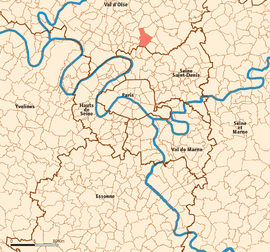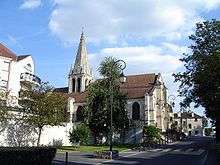Sarcelles
| Sarcelles | ||
|---|---|---|
|
Town hall | ||
| ||
 Location (in red) within Paris inner and outer suburbs | ||
| Coordinates: 48°59′44″N 2°22′51″E / 48.9956°N 2.3808°ECoordinates: 48°59′44″N 2°22′51″E / 48.9956°N 2.3808°E | ||
| Country | France | |
| Region | Île-de-France | |
| Department | Val-d'Oise | |
| Arrondissement | Sarcelles | |
| Canton |
Sarcelles-Nord-Est Sarcelles-Sud-Ouest | |
| Intercommunality | Val de France | |
| Government | ||
| • Mayor (2001–2008) | François Pupponi | |
| Area1 | 8.45 km2 (3.26 sq mi) | |
| Population (2008)2 | 59,221 | |
| • Density | 7,000/km2 (18,000/sq mi) | |
| Time zone | CET (UTC+1) | |
| • Summer (DST) | CEST (UTC+2) | |
| INSEE/Postal code | 95585 / 95200 | |
|
1 French Land Register data, which excludes lakes, ponds, glaciers > 1 km² (0.386 sq mi or 247 acres) and river estuaries. 2 Population without double counting: residents of multiple communes (e.g., students and military personnel) only counted once. | ||
Sarcelles (French pronunciation: [saʁ.sɛl]) is a commune in the northern suburbs of Paris, France. It is located 16.3 km (10.1 mi) from the center of Paris. Sarcelles is a sub-prefecture of the Val-d'Oise department and the seat of the Arrondissement of Sarcelles.
In the south of the commune, during the 1950s and 1960s, HLMs were built in order to accommodate pieds-noirs (French settlers from Algeria) and Jews, who left Algeria due to the Algerian War of Independence. A few Jews from Egypt settled there after the Suez crisis, and Jews from Tunisia and Morocco settled in Sarcelles after unrest and riots against Jews due to the Six-Day War and to the Yom Kippur War.
Transport
Sarcelles is served by Garges – Sarcelles station on Paris RER line D.
It is also served by Sarcelles – Saint-Brice station on the Transilien Paris – Nord suburban rail line. This station, although administratively located on the territory of the neighboring commune of Saint-Brice-sous-Forêt, lies in fact very near the town center of Sarcelles.
Population
| Historical population | ||
|---|---|---|
| Year | Pop. | ±% |
| 1793 | 1,600 | — |
| 1800 | 1,410 | −11.9% |
| 1806 | 1,588 | +12.6% |
| 1821 | 1,327 | −16.4% |
| 1831 | 1,615 | +21.7% |
| 1836 | 1,609 | −0.4% |
| 1841 | 1,735 | +7.8% |
| 1846 | 1,788 | +3.1% |
| 1851 | 1,622 | −9.3% |
| 1856 | 1,604 | −1.1% |
| 1861 | 1,781 | +11.0% |
| 1866 | 1,846 | +3.6% |
| 1872 | 1,682 | −8.9% |
| 1876 | 1,845 | +9.7% |
| 1881 | 2,001 | +8.5% |
| 1886 | 2,159 | +7.9% |
| 1891 | 2,118 | −1.9% |
| 1896 | 2,199 | +3.8% |
| 1901 | 2,384 | +8.4% |
| 1906 | 2,603 | +9.2% |
| 1911 | 2,796 | +7.4% |
| 1921 | 3,364 | +20.3% |
| 1926 | 5,032 | +49.6% |
| 1931 | 6,292 | +25.0% |
| 1936 | 7,083 | +12.6% |
| 1946 | 6,622 | −6.5% |
| 1954 | 8,397 | +26.8% |
| 1962 | 35,800 | +326.3% |
| 1968 | 51,674 | +44.3% |
| 1975 | 55,007 | +6.5% |
| 1982 | 53,630 | −2.5% |
| 1990 | 56,833 | +6.0% |
| 1999 | 57,871 | +1.8% |
| 2008 | 59,221 | +2.3% |
As of 2015 the commune has about 40,000 residents from 40 backgrounds.[1]
Immigration
As of 2007 the majority of the inhabitants of the town are pieds-noirs from Northwest Africa who immigrated to France in the 1960s. Sarcelles is also home to a vibrant Jewish community and the largest concentration of Assyrians in France.[2]
Rahsaan Maxwell, author of Ethnic Minority Migrants in Britain and France: Integration Trade-Offs, stated that compared to other French communities, the ethnic minorities in Sarcelles have more influence, so therefore "Sarcelles should not be considered representative of cities across metropolitan France".[3] Residents believe that there is a "Sarcelles identity," meaning any ethnic group can be a part of the city, and they believe it lowers levels of crime and violence.[4]
Compared to other parts of France, ethnic minorities in Sarcelles gained political power at a faster rate, with gains made in the 1980s instead of the 1990s and 2000s. Many politicians responded to minority demands sooner as many immigrants, especially Caribbeans and Sephardic Jews, had French citizenship. François Pupponi, the mayor in the 2000s dedicated monuments commemorating the histories of ethnic groups,[4] authorized funding of organizations supporting specific ethnic groups such by running Arabic and Hindi language classes[3] and permitted the use of public facilities for religious events.[5] Pupponi argued that this style is the best method of giving many ethnic groups one sense of community.[3] Critics argued that funding groups catering to specific ethnic groups promotes segregation.[4]
| |||||||||||||||||||
Caribbeans
As of 2008 8.7% of the population was of Caribbean in origins.[6] As of 2012 many of the ethnic Caribbean residents have French citizenship.[4]
By the 1970s area Caribbeans became more interested in changing politics, and by then they were residing in the city for a longer period of time. By the 1980s Guy Guyoubli, a local activist, organized an almost-all-Caribbean protest list. Maxwellwrote that this demonstrated that Caribbeans had serious intentions of participating in the political system, even though there were no representatives elected from the lists.[7] At the time ethnic minorities across Metropolitan France were increasingly trying to influence the political system.[7] The city's first ever two Caribbean councilors were elected in 1989. Around 1989 Raymond Lamontagne, the mayor, opened Metropolitan France's first ever Caribbean-oriented, council-funded community center.[4]
Maghrebian Muslims
In the 1950s and 1960s Maghrebians began to arrive in Sarcelles. Political organization came in subsequent decades. Originally the Muslims worshipped in converted makeshift areas, but later purpose-built mosques appeared. In the 1990s Maghrebians were first elected to the commune council. Maxwell wrote that Maghrebians began obtaining "key positions" only in the recent vicinity of 2012 due to "low turnout and weak community organizations".[8]
Assyrian and Chaldean
A memorial to Assyro-Chaldean victims of the 1915 Assyrian genocide was dedicated in 2005.[3] Part of the film The Last Assyrians features the Assyrian and Chaldean community.
Maghrebian Jews
Sarcelles gained a large population of Sephardic Jews as a consequence of the post-World War II Jewish exodus from Arab and Muslim countries. As of 2012 many of the Jewish residents have French citizenship.[4]
During the peak immigration of Sephardic Jews, they subscribed to a belief in assimilation and secularism and they had the North African belief of what Michel Wieviorka and Philippe Bataille, authors of The Lure of Anti-Semitism: Hatred of Jews in Present-Day France, describe as "a structuring role" that "does not cover all aspects of social life".[9] Beginning in the 1980s, religion became more public and important, and Wieviorka and Bataille stated that the previous North African practice is "becoming mixed up with the neo-Orthodox practices of the 'young people' for whom religion controls everything."[9]
In 1983 there was a wave of councilors who were Sephardic Jews.[4]
Crime
In 2012 Maxwell stated that "petty crime" and vandalism became consistent issues and that "violent confrontations" between black migrants, Maghrebians, and Jews was "a recurring theme".[4] He added that by 2012 the commune had "developed a reputation as one of the more dangerous Paris suburbs."[4] Maxwell wrote that local residents told him that the reputation was overblown.[4]
Maxwell wrote that during the 2005 France Riots a report concluded that the damage to buildings in Sarcelles was "relatively moderate" and that a later report concluded that compared to most cities, Sarcelles had fewer days of severe riots.[4] He also stated that local residents characterized the damage as "not as bad as elsewhere and not as bad as one might have expected given Sarcelles's economic and ethnic profile."[4]
International relations

Twin towns – sister cities
Sarcelles is twinned with:
 Netanya, Israel, since 1988[10][11]
Netanya, Israel, since 1988[10][11] Hattersheim, Germany, since 1987
Hattersheim, Germany, since 1987 Martakert, Nagorno-Karabakh Republic, since 2015[12]
Martakert, Nagorno-Karabakh Republic, since 2015[12]
Education
The community has six public collèges and two public lycées. The latter are Lycée Polyvalent de La Tourelle and Lycée Polyvalent J.J. Rousseau.[13]
The Bibliothèque intercommunale Anna Langfus is located in Sarcelles.[14] This library has over 60,000 items and is divided between an adults' section and a children's section.[15] In addition the Espace Musique Mel Bonis is in Sarcelles.[16]
Notable people
- Damien Cely, diver
- Mohamed Dia, fashion designer
- Didier Domi, footballer
- Dimitri Foulquier, footballer
- Eric Sabin, footballer
- Younousse Sankhare, footballer
- Jean-Manuel Thetis footballer
- Frederic Thomas, footballer
- Jonathan Tokple, footballer
- Youssouf Toure, footballer
- Steeve Yago, footballer
- Riyad Mahrez, footballer
- Amir Haddad, singer
- Miss Dominique, singer
- Dominique Strauss-Kahn, former mayor of Sarcelles
- Les Twins, New Style dancers
See also

Notes
- ↑ "Sarcelles, ville ghetto ou cité modèle ?". France Télévisions. 2015-03-04. Retrieved 2016-09-14. "A 15 kilomètres de Paris, Sarcelles ses 40 000 habitants et ses 40 communautés différentes,[...]"
- ↑ Wieviorka and Bataille, p. 166-167. "The ChaldoAssyrian Community What saved Sarcelles and rid it of the reputation associated with 'Sarcel-litis was undoubtedly due to its Jewish population, which unaware of the drawbacks of concrete urbanisation, emphasised the positive[....]"
- 1 2 3 4 Maxwell, Ethnic Minority Migrants in Britain and France: Integration Trade-Offs, p. 171.
- 1 2 3 4 5 6 7 8 9 10 11 12 Maxwell, Ethnic Minority Migrants in Britain and France: Integration Trade-Offs, p. 170.
- ↑ Maxwell, Ethnic Minority Migrants in Britain and France: Integration Trade-Offs, p. 170-171.
- ↑ Maxwell, Rahsaan Daniel. Tensions and Tradeoffs: Ethnic Minority Migrant Integration in Britain and France. ProQuest, 2008. p. 197. ISBN 0549874585, 9780549874584.
- 1 2 Maxwell, Ethnic Minority Migrants in Britain and France: Integration Trade-Offs, p. 172.
- ↑ Maxwell, Ethnic Minority Migrants in Britain and France: Integration Trade-Offs, p. 179.
- 1 2 Wieviorka and Bataille, p. 165.
- ↑ Sarcelles - France, Netanya municipality website.
- ↑ "Netanya - Twin Cities". Netanya Municipality. Archived from the original on 2013-02-01. Retrieved 2013-08-01.
- ↑ Karabakh's Martakert and Sarcelles sign cooperation agreement
- ↑ "Les établissements scolaires." Sarcelles. Retrieved on June 3, 2014.
- ↑ "Bibliothèque intercommunale Anna Langfus à Sarcelles." Val de France. Retrieved on 3 June 2014. "Bibliothèque intercommunale Anna Langfus 37 Boulevard Bergson 95200 Sarcelles"
- ↑ "Bibliothèque Anna Langfus." Val de France. Retrieved on 3 June 2014. "Bibliothèque Intercommunale Anna Langfus 37 boulevard Henri Bergson (2ème étage) 95200 Sarcelles"
- ↑ "Espace Musique Mel Bonis." Val de France Intercommunal Libraries. Retrieved on June 3, 2014. "Espace musique Mel Bonis à Sarcelles 1, Place de Navarre, Les Flanades 95200 Sarcelles"
References
- Maxwell, Rahsaan. Ethnic Minority Migrants in Britain and France: Integration Trade-Offs. Cambridge University Press, 5 March 2012. ISBN 1107378036, 9781107378032.
- Wieviorka, Michel; Bataille, Philippe (2007). The lure of anti-Semitism: hatred of Jews in present-day France. BRILL. ISBN 9789004163379.
- INSEE
- Association of Mayors of the Val d’Oise (French)
External links
| Wikimedia Commons has media related to Sarcelles. |
- Official website (French)
- Mérimée database - Cultural heritage (French)
- Land use (IAURIF) (English)

.svg.png)